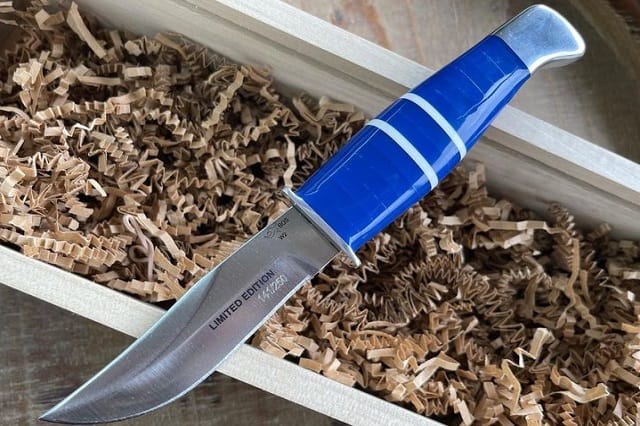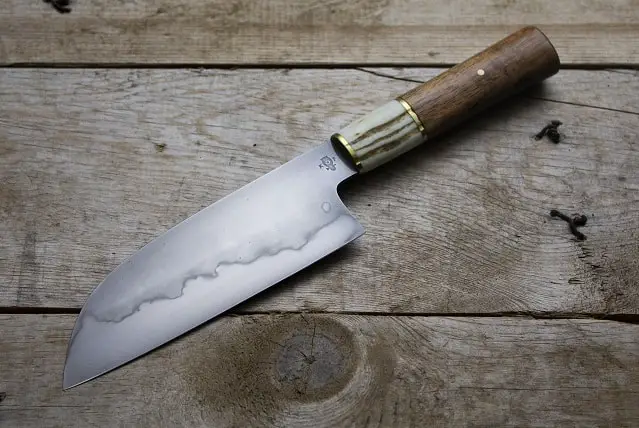(This site is reader-supported. When you buy something using retail links on our articles, we may earn a small commission. As an Amazon Associate I earn from qualifying purchases.)
Have you ever seen katana-style swords? Have you come across knives featuring an elegant temper line called the Hamon? If the reply to any of these questions is YES, you may have seen a tool made up of W2 carbon steel. Carbon steels are admired for their unbelievable hardness.
In this post, let’s explore its chemical composition, properties, and performance in comparison with other steels.
What is W2 Steel?

W2 is water-hardening steel that both seasoned and beginner custom knife makers use. Water-hardening steels are termed W steels such as W1 and W3. W stands for water quench steel; whereas, 2 signifies its version.
There was a time when the production of this steel had stopped. These days NJSB produces it. It is used in making larger and tougher knives featuring thicker spines, despite its high hardness level as the core of the thick portion of the blade does not attain full hardness because of the shallow hardening nature of the steel. It is also used for producing machine dies and hand tools. It is also used for making custom knives with a spectacular look and decorative blades.
The W2 tool steel is considered ideal for introducing Hamons, a visually striking upshot on a blade surface by the hardening process. This process is popular amongst Japanese swordsmiths.
Chemical Composition
W2 is a high carbon and low chromium blend, which means it is a high carbon Steel. Following are the elements that constituents this carbon steel:
- 1.15% Carbon: For increased hardness and a higher ability to resist wear than normal
- 0.25% Manganese: For improved forgeability, tensile strength, hardenability, and resistance to wear
- 0.25% Silicon: For greater strength
- 0.20% Nickel: For a higher level of toughness
- 0.20% Copper: For improved resistance to corrosion
- 0.15%: Vanadium: For better resistance to shock loading, toughness, hardenability
- 0.15% Chromium: For great edge retention, tensile strength, hardness, and toughness, and resistance to corrosion and wear
- 0.15% Tungsten: For more strength and toughness
- 0.10% Molybdenum: For better machinability as well as strength
- 0.025% Sulfur: For better machinability and impact toughness
Hardness
On the Rockwell scale, W2 has a hardness rating between 62 and 65 HRC. Thus, it is an extremely hard steel to last in terms of performance, even with a thin edge. The exact rating is likely to vary as per the amount of carbon used and given heat treatment. The high hardness rating is attributed to high carbon content.
Properties
- Decent Toughness: W2 is quite hard, due to which you may think that it is likely to be less tough. However, this is not true. Although the level of hardness is high, this steel manages to ensure decent toughness such that its blade will not chip easily. Still, you cannot escape the fact that hardness and toughness are inversely proportional. While chipping can be prevented, frequent abuse may result in damages. At 65 HRC, this steel is just not that tough to keep this hard-use-induced damage at bay.
- Great Edge Retention: This is where this steel excels because of its high level of hardness. A W2 knife can retain its sharp edge for a long time despite cutting efficiently all day long. Several knife makers claim that a knife blade made using this steel offers efficient cutting performance throughout the day.
- Great Wear Resistance: The high level of hardness of this steel ensures excellent resistance to the impact of wear. The credit for this again goes to the addition of carbon, chromium, and manganese.
- Poor Corrosion Resistance: W2 does not perform well when it comes to resisting corrosion, stains, or rust. This is attributed to the low amount of chromium present.
- Ease of Sharpening: As the hardness level is high, it is tough to sharpen a W2 steel edge. You would need to spend some more time sharpening its blade using a sharpening device.
Comparison With Other Knife Steel Options
Now that you are aware of the chemical composition and properties of W2 steel, it is time to see how it fares against other popular steel options.
W2 vs W1
Both steels belong to the family of water hardening tool steels. In terms of chemical composition, both are almost the same. However, W2 has vanadium, due to which its hardenability and wear resistance are better than W1. It is also preferable for embellishing knife blades with great Hamon effects.
W2 vs 1095
1095 has more carbon than its sister steel, 1080. Still, it is not as hard as W2. This water hardening tool steel wins in terms of edge retention and wear resistance. 1095 also is not resistant to corrosion just like W2. However, it is tougher, more resistant to chipping, and is easier to sharpen.
W2 vs 5140
5140 has a lower amount of carbon than W2. This means this water quench steel is better at resisting wear and retaining a sharp edge. However, 5140 wins when it comes to ease of sharpening, as it is easier to sharpen due to less carbon content.
W2 vs 1084
As 1084 has less carbon than W2, it loses in terms of wear resistance and edge retention. However, it is easier to sharpen an edge made using the 1084 steel.
So, is W2 Steel Good?
Yes, if you want decorative knives with Hamon, swords, or kitchen knives. Although this carbon steel is hard and known for its ability to retain a sharp edge for a long time, we feel there are better steels available at the same price range for your outdoor knives. Because of poor corrosion resistance, a W2 knife needs regular oiling and cleaning after use.

Hi, I am Jay. I am the creator of Knife Guides, your one-stop site for everything related to knives. I am a computer engineer by profession, knife aficionado by passion. Here I work with a group of people who’ve always had a passion for knives and blades. Over the years we’ve kind of become experts and decided to share our knowledge and ideas. I am also an avid hiker and enjoy offshore gamefishing.

